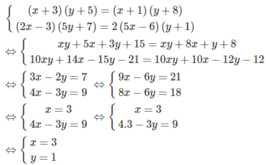Giải các hệ phương trình: 1 , 7 x - 2 y = 3 , 8 2 , 1 x + 5 y = 0 , 4

Những câu hỏi liên quan
Giải các hệ phương trình:
x
+
3
y
+
5
x
+
1...
Đọc tiếp
Giải các hệ phương trình: x + 3 y + 5 = x + 1 y + 8 2 x - 3 5 y + 7 = 2 5 x - 6 y + 1

Vậy hệ phương trình đã cho có một nghiệm (x; y) = (3; 1)
Đúng 0
Bình luận (0)
Giải các hệ phương trình sau:
{ (x - 5)(y - 2) = (x + 2)(y - 1)
{ (x - 4)(y + 7) = (x - 3)(y + 4)
\(\left\{{}\begin{matrix}\left(x-5\right)\left(y-2\right)=\left(x+2\right)\left(y-1\right)\\\left(x-4\right)\left(y+7\right)=\left(x-3\right)\left(y+4\right)\end{matrix}\right.\)
\(\Leftrightarrow\left\{{}\begin{matrix}xy-2x-5y+10=xy-x+2y-2\\xy+7x-4y-28=xy+4x-3y-12\end{matrix}\right.\)
\(\Leftrightarrow\left\{{}\begin{matrix}x+7y=12\\3x-y=16\end{matrix}\right.\) \(\Leftrightarrow\left\{{}\begin{matrix}3x+21y=36\\3x-y=16\end{matrix}\right.\)
\(\Leftrightarrow\left\{{}\begin{matrix}22y=20\\x+7y=12\end{matrix}\right.\) \(\Leftrightarrow\left\{{}\begin{matrix}x=\dfrac{62}{11}\\y=\dfrac{10}{11}\end{matrix}\right.\)
Đúng 2
Bình luận (0)
Giải các hệ phương trình sau:
a.{1/x - 1/y = 1
{2/x - 3/y = 5
b.{15/x - 7/y = 9
{4/x + 9/y = 35
\(a,\Leftrightarrow\left\{{}\begin{matrix}\dfrac{2}{x}-\dfrac{2}{y}=2\\\dfrac{2}{x}-\dfrac{3}{y}=5\end{matrix}\right.\left(x,y\ne0\right)\Leftrightarrow\left\{{}\begin{matrix}-\dfrac{5}{y}=3\\\dfrac{2}{x}-\dfrac{3}{y}=5\end{matrix}\right.\Leftrightarrow\left\{{}\begin{matrix}y=-\dfrac{5}{3}\\\dfrac{2}{x}+\dfrac{9}{5}=5\end{matrix}\right.\\ \Leftrightarrow\left\{{}\begin{matrix}x=\dfrac{5}{8}\\y=-\dfrac{5}{3}\end{matrix}\right.\)
\(b,\Leftrightarrow\left\{{}\begin{matrix}\dfrac{60}{x}-\dfrac{28}{y}=36\\\dfrac{60}{x}-\dfrac{135}{y}=525\end{matrix}\right.\left(x,y\ne0\right)\Leftrightarrow\left\{{}\begin{matrix}\dfrac{4}{x}+\dfrac{9}{y}=35\\-\dfrac{163}{y}=489\end{matrix}\right.\Leftrightarrow\left\{{}\begin{matrix}\dfrac{4}{x}-27=35\\y=-\dfrac{1}{3}\end{matrix}\right.\\ \Leftrightarrow\left\{{}\begin{matrix}x=\dfrac{2}{31}\\y=-\dfrac{1}{3}\end{matrix}\right.\)
Đúng 2
Bình luận (0)
a: Ta có: \(\left\{{}\begin{matrix}\dfrac{1}{x}-\dfrac{1}{y}=1\\\dfrac{2}{x}-\dfrac{3}{y}=5\end{matrix}\right.\)
\(\Leftrightarrow\left\{{}\begin{matrix}\dfrac{2}{x}-\dfrac{2}{y}=2\\\dfrac{2}{x}-\dfrac{3}{y}=5\end{matrix}\right.\Leftrightarrow\left\{{}\begin{matrix}\dfrac{1}{y}=-3\\\dfrac{1}{x}-\dfrac{1}{y}=1\end{matrix}\right.\Leftrightarrow\left\{{}\begin{matrix}y=\dfrac{-1}{3}\\\dfrac{1}{x}=1+\dfrac{1}{y}=1+\left(-3\right)=-2\end{matrix}\right.\)
\(\Leftrightarrow\left\{{}\begin{matrix}y=-\dfrac{1}{3}\\x=\dfrac{-1}{2}\end{matrix}\right.\)
Đúng 1
Bình luận (0)
cho hệ phương trình
\(\left\{{}\begin{matrix}-2mx+y=5\\mx+3y+1\end{matrix}\right.\)
a)giải hệ phương trình khi m=2
b)giải hệ phương trình theo m
c)tìm m để hệ có nghiệm (x;y) là các số dương
d)tìm m để hệ phương trình có nghiệm thỏa mãn x^2+y^2=1
Mình mạn phép sửa lại phương trình $2$ của bạn là $mx+3y=1$ nhé.
ĐK: $m\neq 0$
a) Khi $m=2,$ hệ phương trình là:
\(\left\{{}\begin{matrix}-4x+y=5\\2x+3y=1\end{matrix}\right.\Leftrightarrow\left\{{}\begin{matrix}-4x+y=5\\4x+6y=2\end{matrix}\right.\Rightarrow7y=7\Leftrightarrow y=1\Rightarrow x=-1\)
b) \(\left\{{}\begin{matrix}-2mx+y=5\\mx+3y=1\end{matrix}\right.\Leftrightarrow\left\{{}\begin{matrix}-2mx+y=5\\2mx+6y=2\end{matrix}\right.\Rightarrow7y=7\Leftrightarrow y=1\Rightarrow x=-\dfrac{2}{m}\)
c) Do ta luôn có $y=1$ là số dương nên chỉ cần chọn $m$ sao cho:
\(x=-\dfrac{2}{m}>0\Leftrightarrow m< 0\)
d) \(x^2+y^2=1\Leftrightarrow\left(-\dfrac{2}{m}\right)^2+1^2=1\Leftrightarrow\dfrac{4}{m^2}=0\) (vô lý)
Vậy không tồn tại $m$ sao cho $x^2+y^2=1.$
Đúng 3
Bình luận (0)
1) Giải hệ phương phương trình trình 1/(x - 2) - 2sqrt(y + 1) = - 4; 2/(x - 2) + sqrt(y + 1) = 7
ĐKXĐ: x<>2 và y>=-1
\(\left\{{}\begin{matrix}\dfrac{1}{x-2}-2\sqrt{y+1}=-4\\\dfrac{2}{x-2}+\sqrt{y+1}=7\end{matrix}\right.\)
=>\(\left\{{}\begin{matrix}\dfrac{2}{x-2}-4\sqrt{y+1}=-8\\\dfrac{2}{x-2}+\sqrt{y+1}=7\end{matrix}\right.\)
=>\(\left\{{}\begin{matrix}-5\sqrt{y+1}=-15\\\dfrac{2}{x-2}+\sqrt{y+1}=7\end{matrix}\right.\Leftrightarrow\left\{{}\begin{matrix}\sqrt{y+1}=3\\\dfrac{2}{x-2}=7-3=4\end{matrix}\right.\)
=>\(\left\{{}\begin{matrix}y+1=9\\x-2=\dfrac{1}{2}\end{matrix}\right.\Leftrightarrow\left\{{}\begin{matrix}y=8\\x=\dfrac{5}{2}\end{matrix}\right.\left(nhận\right)\)
Đúng 1
Bình luận (0)
bài 1: giải các phương trình sau :
a) x^3-5x=0 b) căn bậc 2 của x-1=3
bài 2 :
cho hệ phương trình : {2x+my;3x-y=0 (I)
a) giải hệ phương trình khi m=0
b) tìm giá trị của m để hệ (I) có nghiệm (x;y) thỏa mãn hệ thức :
x-y+m+1/m-2=-4
bài 3:giải các phương trình sau
a)5x-2/3=5x-3/2 b) 10x+3/12=1+6x+8/9 c) 2(x+3/5)=5-(13/5+x) d) 7/8x-5(x-9)=20x+1,5/6
Giải các phương trình và hệ phương trình sau :
1. \(3x^2-7x+2=0\)
2. \(x^4-5x+4=0\)
3. \(\left\{{}\begin{matrix}\sqrt{5}x-2y=7\\x-\sqrt{5}y=2\sqrt{5}\end{matrix}\right.\)
1. 3x( x - 2 ) - ( x - 2 ) = 0
<=> ( x-2).(3x-1) = 0 => x = 2 hoặc x = \(\dfrac{1}{3}\)
2. x( x-1 ) ( x2 + x + 1 ) - 4( x - 1 )
<=> ( x - 1 ).( x (x^2 + x + 1 ) - 4 ) = 0
(phần này tui giải được x = 1 thôi còn bên kia giải ko ra nha )
3 \(\left\{{}\begin{matrix}\sqrt{5}x-2y=7\\\sqrt{5}x-5y=10\end{matrix}\right.\)<=> \(\left\{{}\begin{matrix}y=-1\\x=\sqrt{5}\end{matrix}\right.\)
Đúng 1
Bình luận (0)
\(1. 3x^2 - 7x +2=0\)
=>\(Δ=(-7)^2 - 4.3.2\)
\(= 49-24 = 25\)
Vì 25>0 suy ra phương trình có 2 nghiệm phân biệt:
\(x_1\)=\(\dfrac{-\left(-7\right)+\sqrt{25}}{2.3}=\dfrac{7+5}{6}=2\)
\(x_2\)=\(\dfrac{-\left(-7\right)-\sqrt{25}}{2.3}=\dfrac{7-5}{6}=\dfrac{1}{3}\)
Đúng 0
Bình luận (0)
Giải hệ phương trình
x-4y=5
2|x-2y|+|x+y-1|=7
Giải các hệ phương trình
x
-
3
y
+
2
x
-
7...
Đọc tiếp
Giải các hệ phương trình x - 3 y + 2 x = - 7 - 2 x + 4 y + 3 z = 8 3 x + y - z = 5

Đưa hệ phương trình về hệ dạng tam giác bằng cách khử dần ẩn số.
Nhân phương trình (1) với 2 rồi cộng với phương trình (2) và nhân phương trình (1) với (3) rồi trừ đi phương trình (3) ta được:

Giải hệ phương trình trên ta được 
Vậy hệ phương trình có nghiệm 
Đúng 0
Bình luận (0)
cho hệ phương trình :{x+my=3 và mx+4y=7
1,giải hệ phương trình khi m=3
2,tìm m để hệ có nghiệm{x>1 và y>0
1/ khi m=3 ta có
x+3y=3
3x+4y=7
<=>x=3-3y
3(3-3y)+4y=7
<=>x=3-3y
3y+4y=7
<=>x=3-3y
7y=7
==>y=1
<=>x=3-3y
=>x=3-3.1
=>x=3-3
==>x=0
vây x=0 ; y=1
Đúng 0
Bình luận (0)




















